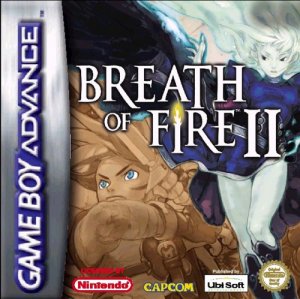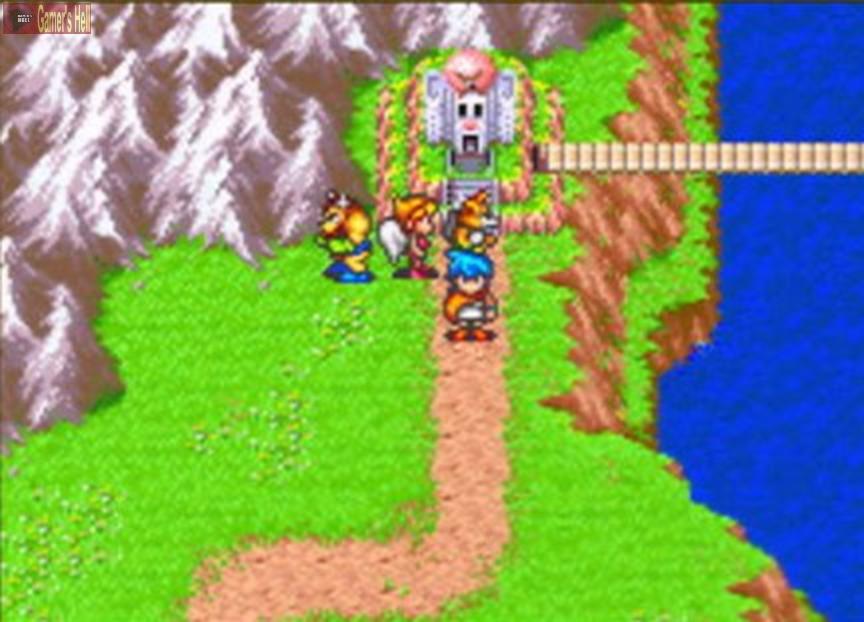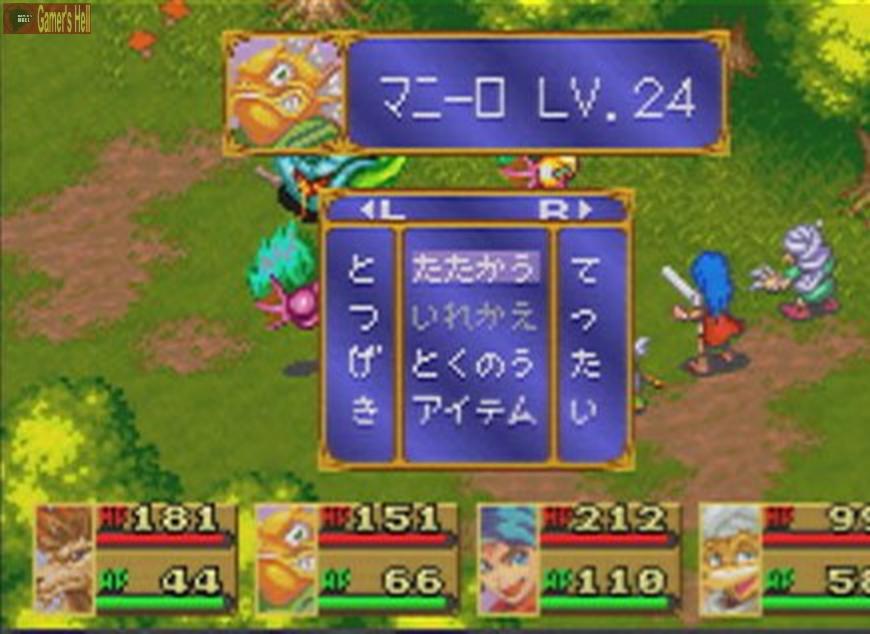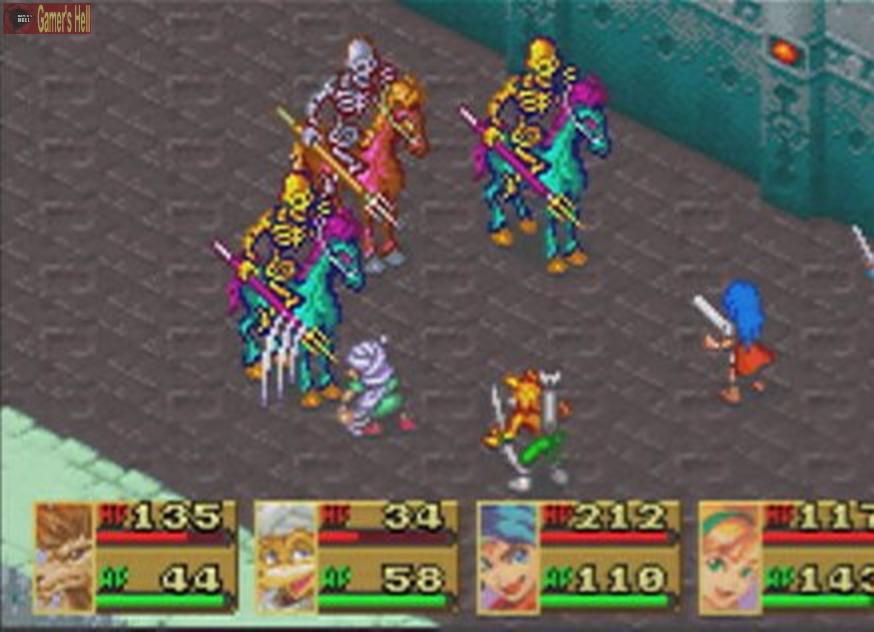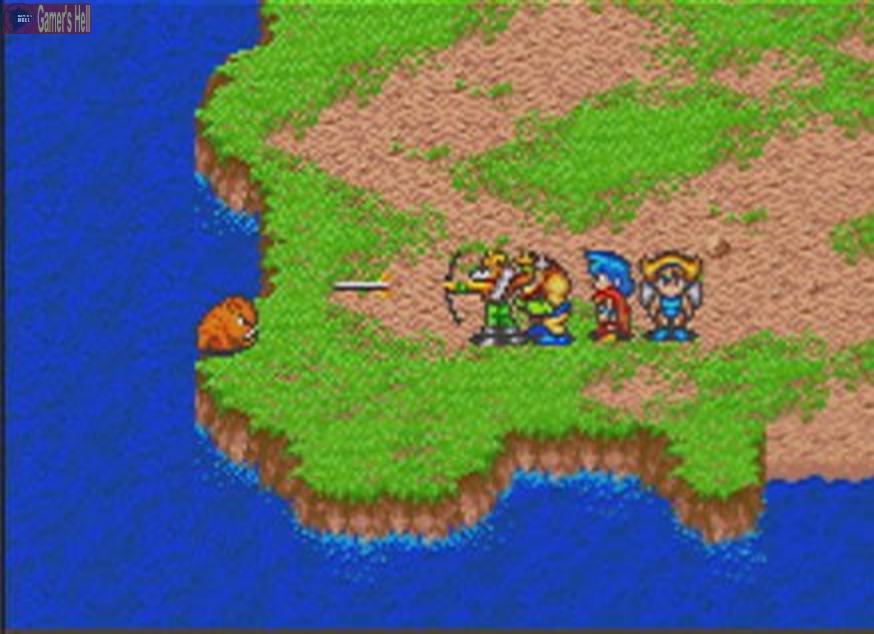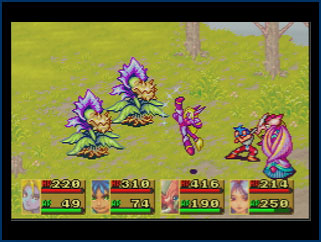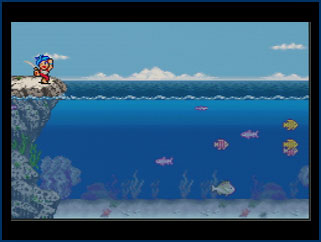Breath of Fire II is the sequel to Breath of Fire. It is set 500 years in the future, and stars a couple of familiar faces from the first game, along with a brand new cast and amazing story.
Full Review
Breath of Fire II Review
By, Tony Ames
Backdrop
.hack Part 1 Infection (Dot Hack) begins with a bang. Something disastrous happens to your character‘s real world friend, while innocently playing a 20 million-subscriber base, wildly popular online RPG game (MMORPG), The World. To unravel the mystery of your friend’s misfortune, you become an online, ingame rogue hacker, exploring every corner of The World, even some virus-infected ones.
The hero is armed with the special skills of Data Drain and Gate Hack, and some colorful, talented fellow adventurers to fill the two other available party slots. Different adventurers must accompany you depending on the plot‘s development. You have some control over the others in your party, including upgrading them through trades or gifts. You can play only a single class, Twin Blade. Other characters are from different classes, with varied strengths and weaknesses, from a mage type (Wavemaster) to a bully (Heavy Axeman).
Gameplay
Gameplay takes place in three principal areas – towns, fields, and dungeons. Towns house The World’s servers. There, the player can save the game, buy magic scrolls and useful and unique items, store items, buy equipment, and talk and trade with lots of other players in character online. One town has an unusual ranch to check out, a patent homage to an enduring feature of just about every Final Fantasy.
The town’s Chaos Gate provides instant teleportation to a particular wide-open Field, containing monster encounter hotspots, a mystical spring, treasure, and lots of mysterious food. You enter three distinct keywords, some known at the game‘s onset, and others learned through play. Whatever keywords are entered, the difficulty level of the destination is helpfully revealed. This prevents a low-level party from being massacred. Once the keywords are entered, you travel through the Chaos Gate. (You can enter specific keywords learned to continue the plot, do side quests, or do unlimited exploring. Or, you can instruct the Gate to enter random keywords, and take your chances. There‘s also an option to enter any keywords you wish from a word list.) Every Field houses a single Dungeon. The dungeons, where you spend much of the game fighting for your life, are not overly large in size, and always range between three and five average levels.
Many have compared Dot Hack to Phantasy Star Online Episode I and II (PSO) on the Gamecube. Let us gently discredit this. We feel Dot Hack has far better graphics than PSO. The Fields and Dungeons contain many colorful, over stylized backdrops and settings, including weather effects. Dot Hack’s monsters resemble the beautifully-drawn monsters of the later Final Fantasy’s. Dot Hack’s world is gigantic with a seeming infinite number of locations to explore. PSO’s world is relatively small, and plot is threadbare, with meaningless, though fun, side quests, which instill no enthusiasm in the player. Dot Hack’s plot is deep and complex, with each subplot advancing the story just a little bit further. (Remember though, the end of this game in no way comes close to wrapping up the story, to be completed in the three games to be released later this year.) One visual treat, however, was lifted directly from PSO – the cascading rings that accompany the teleportation of characters to and from different areas.
Combat
Dot Hack’s combat engine can best be described as modified real-time. Much like the action-RPG, Kingdom Hearts, button mashing can be effective to beat monsters. Monster combat icons appear as large yellow twirling landmarks. As you approach, the landmark dissolves, monsters come at you big-time, and, undoubtedly, players will feel a healthy adrenaline rush. Some of Dot Hack’s many monsters do not stand around waiting to be pummeled, rather some you need to catch. Dot Hack lets you turn combat almost into a turn-based affair. The player needs only to hit Triangle in the middle of battle to pause the game instantly. From there the player can give orders to the others in the party, anything from healing someone, reviving another, casting a spell, designating a target monster. Without jeopardizing your party from the hailstorm of monster blows, combat becomes a calmer, more strategic, experience. This will help the many action-challenged. Camera angles play a big role in successful combat. You must be facing a monster to do any damage. As in many games, manipulating opposing environmental elements, like fire vs. water, is a key to successful monster combat.
Dot Hack’s cyberspace setting provides a wealth of Wow-inducing outbursts. The Data Drain option in combat is a great example. When a monster’s approaches zero, the player can Data Drain to reduce a horrendous, gigantic steel robot, for example, into a sniveling, puny monster, easily defeated with a single blow. Data Drain always results in a nifty, rare item or essential Virus Cores so you can Gate Hack areas of The World now closed, but needing investigation. One bad side effect – if you defeat, a Data Drained monster, but a single experience point is earned. One REALLY bad side effect – if you Data Drain too often without giving the skill a rest, you may overload and explode. Game Over. In the case of Boss monsters, Data Drain works the same, but what remains is no sniveling puny monster, but a full-blooded slightly less tough monster. All of this makes for interesting and captivating combat, a large part of the game.
Fresh Features
Dot Hack is replete with new and interesting features that kept us riveted.
To start, the entire background and story of a real world gamer becoming a rascal hacker, penetrating deep into a virus-infected online game, is quite novel. Combine this with Dot Hack’s emulating the look and feel of an online game universe. (Message traffic on the web shows many gamers mistakenly believe Dot Hack is a real online MMORPG, along with monthly fees! No real Internet connection is required.)
Just like in the real word, Dot Hack replicates your excitement level when “New” appears before a popular forum or on your email screen. Some of the game involves receiving emails as the plot develops, as well as new, crucial information surfacing on The World’s Board. (Look out for emails challenging you to a strange game of Tag.) The online game world looks very familiar with a bunch of characters wandering around the game’s towns, with the ubiquitous balloon icons talking typical “trash” to each other, even criticizing “newbies“.
Combat grippingly called for surprisingly strategic decision-making to succeed, not related to the usual attack or defend choices. Do you go for experience and upgrade your character or try for some special equipment or a Virus Core, vital to Gate Hacking? The innovative control of other party members became second nature to us after some practice. The game rewards a player taking chances, like entering a Field or Dungeon rated 5 levels above the player’s current level. On the other hand, the game scoffed at players entering areas much lower rated the their current level, by awarding negligible experience points for victory.
Dot Hack takes progress reports to a new level, by slowly unlocking books that contain much in the way of statistics and information. There’s even a monster compendium with tips for defeating them.
Some might complain about the minimal “Save Game” ability, but we thrived on it. You explore a very hostile cyberspace environment without the facility to save. Only in a server-hosting town is saving possible at the local Recorder. We may be a solitary voice in the Wilderness, but we like this throwback to the good old RPG days. Those of you old enough to remember the Wizardry series, may recall those fingernail-biting multi-combat treks back to the Castle just to save the game. In case you’re really stuck deep in a dungeon, a common item will teleport you to the outdoor field, from where you can simply gate back to town from the command menu.
Many pieces of equipment come with distinctive powerful attack, healing, and status skills, essential to combat dominance. The player must tradeoff whether to equip something that will raise defense or offense or something less vigorous that lets you use a powerful skill. Trading is the most successful way to upgrade equipment.
In a first, Dot Hack comes with a 45 minute anime video. This gives some great background on what’s going on in The World, as well as provide clues for completing the game. In a nice twist, voiceovers for game speech can be set for Japanese or English presentation. Listening to the authentic Japanese voices really keeps you glued to the game.
Though some may scoff at what follows as meaningless, we liked the game’s unlocking of some nifty new “toys” to like, some only available when the game is cleared. You can unlock many different background music play lists. Tired of creepy tunes, just switch to something more upbeat, or futuristic. Just like real world gamers, who constantly change their desktop wallpaper, new and different wallpapers are unlocked along the way. Some are concept art of characters, while others are full blown anime renditions of the characters. This makes for great fun, and seems to pump additional energy into the game. As you progress over a dozen special cut scenes or movies will become viewable after defeating the game.
Though Dot Hack’s extras and new wrinkles enhance the RPG game experience, much of the gameplay will ring true to those who enjoy RPG‘s. Expect plenty of exploration in a huge 3D world, frequent monster combat, tons of treasure to earn and discover, upgrading your character’s weapons and armor, and needing to level before tackling pivotal story dungeons. The status screens for the characters and all equipment are well laid out and easy to grasp.
Time for Completion
Game length in hours always concerns many purchasers. A short RPG normally takes a lot of flack, and many online are asking about Dot Hack‘s time for completion. (Some have questioned whether Bandai should have released a single 80 hour game for $50, rather than four 20-hour games for $200 for a single story. This matter is beyond the scope of this review, but our high opinion of this game as a standalone is obvious.) Our experience, playing the plot without doing side quests or extra exploration, is in the 12 to 15-hour range. Players side-questing and extensively exploring, aside from the main plot, can expect to spend 25 hours to complete the game. You can even continue to advance your character, after game completion, to get a jump start on Part 2 due in May. In the next game, your character can be imported from Part 1.
Furthermore, imagine trying to explore every nook and cranny of the fields and dungeons accessible by a large number of 3-word combinations. Doing that would put the game in the 50-hour range, if not more. However, at a certain point, new items dry up, and a single experience point is earned for any defeated monster, no matter how tough.
Shortcomings
While, as is evident above, there is much to recommend in Dot Hack, certain concerns to varying degrees deserve mention.
From the “Why oh why did they leave this out?“ File. Pregame game board traffic and information about the Japanese version released months ago had many salivating for replaying the game in “parody” mode. This mode apparently converted all Dot Hack’s game world characters into satirical comedians. Sorry to say, this highly-anticipated feature is missing from the version released here.
The game requires massive amounts of button pressing. Every item or treasure uncovered from combat victories or exploration (opening chests, searching expired adventure remains, collecting food for Grunty’s, as examples) must be confirmed with a button press. When there could be 50-100 such occurrences in a single dungeon or field, over the course of the game, finger cramps seem inevitable. Baldur’s Gate: Dark Alliance also required lots of bashing for buried treasure and chests, but the items literally flew into your inventory, a much better way to handle this.
The manual is woefully terse and lacking in some crucial information and guidance. While the ingame tutorials fill in many of the gaps, one extremely important gameplay feature is missing from both the manual and tutorials – instructions on control your characters directly during combat.
Final Word
We got a kick out of Dot Hack. The feeling of “just one more dungeon” dominated our lives for the 3 days to completion. The engaging environment held our attention without much effort. The strategic nature of combat, plus the convoluted plot kept us going for hours on end. The constant unlocking of both frivolous and important gameplay features created a “what’s next” anticipation. Now, if I could only read Japanese better, Dot Hack Part 2 is already out in Japan!
Final Grade: B
When you think about it, games like this Breath of Fire II re-release are quite amazing. Just set the cartridge next to its Super Nintendo counterpart. It’s astounding. Pity the game itself does nothing that impresses half as much as this little exercise.
It’s always a little depressing when you look at the instruction manuals for games on the GBA. Most of them have really good character art. But the game, limited by technology, falls short. It doesn’t look bad, of course, especially if you like older sprite-driven graphics. It’s just disappointing.
Actually, when something is limited by technology, the thought of what might have been always nags. I mean, listening to Breath of Fire II’s music makes me cringe a little. But, when I pull out some headphones and listen to the composition, I start thinking about how the game would sound with real instruments. But, imagination doesn’t change the fact that the synthesized instruments sound like crap.
What were most annoying though were the personal actions. Several characters have abilities on the world map that allows you to navigate areas of it. Which is ultimately a not-so-subtle way of forcing certain members into the party. Which isn’t unbearable on its own, but then it leads to some of the most pointless quests I’ve ever seen.
For example: You’re chasing this bat-winged woman to prove your friend innocent. You find a frog in the woods. He asks you to get a witch to change him back. You scale a tower, beat the witch, and the frog becomes… a frogman. The frogman lets you access a town in the lake. There, he’s arrested for ‘impersonating’ the prince. Then his sister asks you to prove him to be the real prince. It turns out he gave his royal pendant to the witch as a gift. You go to her tower, but she isn’t home. Then you track her to this restaurant, and get it back. You take the pendant back, and it turns out the fake already has a fake pendant. So they decide to have a cooking contest. You have to go find worms, cockroaches, and flies to use as ingredients. You do that, fighting three bosses, then it turns out the contest is rigged anyway. But then the fakes cover is blown, so he takes the princess and runs. You catch him, he transforms into a demon, and you kill him. After all that, you talk to the chef, and he tells you that they recently caught a bat-winged woman. And then you tell them you need her, and they let you have her.
What’s really sad is that this is not the first thing that happens when you start looking for this girl. You have 3 other slightly shorter but similarly pointless quests. In other words, you spend nearly half the game doing one thing that ultimately doesn’t effect the overall plot.
It doesn’t help that in all of this very little attention is paid to the cast. In fact, most of them wind up pretty much the same as the plot- pointless and fluffy. Well, that’s not entirely fair. There are a few funny scenes involving the female cast, generally involving heaping abuse on hapless bystanders. Other than that, each gets an obligatory quest devoted to them, after which you they could burst into flames and the story wouldn’t notice.
Really, the best part of the game is combat, which isn’t without its problems. Tried and true turn-based combat is the flavor of the day, with no particular additions either. There’s an interesting system called Shamanizing, which allows your characters to join up with Shamans, altering their appearance and stats. Of course, you have to scour the earth to find these Shamans, if you want them. You don’t necessarily need them though. But that’s not why combat stands out. Instead, it’s because as the game progresses the bosses become a fairly good challenge, thus making Breath of Fire II a worthwhile game to those that want to sweat a little in fights, at the very least.
The game has relatively little to offer besides the main quests and seeking out Shamans, and is fairly short by modern standards. I don’t have an exact time, but the game couldn’t have lasted longer than 25 hours. In fairness, that’s pretty typical of Super Nintendo RPGs, if not a bit above average.
Ultimately though, I can’t say that I really enjoyed Breath of Fire II. The story is almost insulting until nearly the end, I didn’t like the characters, and combat was by and large pretty boring with all too many encounters. But, the latter half of the game is worthwhile for people seeking a degree of challenge, and the game is fairly inexpensive nowadays, so it may be an option for those with tighter budgets.
Final Verdict: 62%

